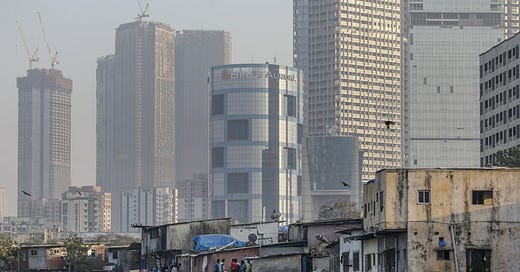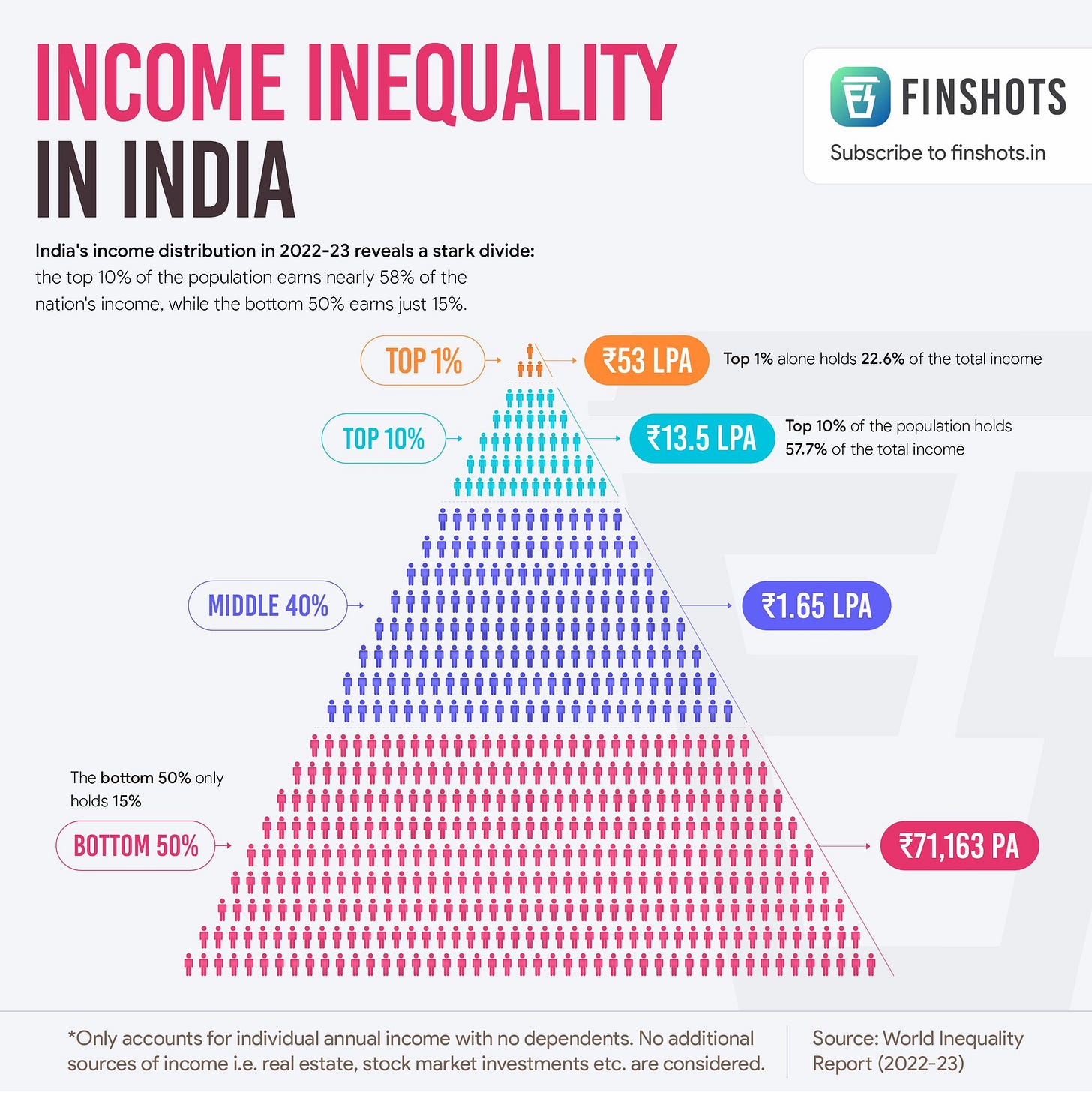Income inequality is a stark reality in India, a country of over 1.4 billion people, where the coexistence of immense wealth and abject poverty is a defining paradox. While skyscrapers light up the skyline of cities like Mumbai, Bengaluru, and Delhi, millions still live in slums with no access to basic amenities. This economic disparity reflects not just numbers but stories of struggle, resilience, and hope.
Inequality rising since 2000s, top 1 per cent in India holds 40 per cent wealth: study
Inequality in India has skyrocketed since the early 2000s, with the income and wealth share of the top one per cent of the population rising to 22.6 per cent and 40.1 per cent, respectively, in 2022-23, according to a working paper. The paper titled “Income and Wealth Inequality in India, 1922-2023: The Rise of the Billionaire Raj” stated that between 2014-15 and 2022-23, the rise of top-end inequality has been particularly pronounced in terms of wealth concentration.
Stories of Inequality:
1. The Dream of a Better Future
Sanjay, a 14-year-old boy from a Mumbai slum, dreams of becoming a software engineer. His father works as a daily wage laborer, earning just enough to feed the family. Sanjay studies by the dim light of a kerosene lamp every night, while his wealthier peers attend coding classes and use high-speed internet. Despite his talent and determination, the lack of resources threatens to clip his wings.
2. The Struggle for Healthcare
In 2022, an incident in a remote village in Odisha highlighted the stark healthcare divide. Sunita, a pregnant woman, had to be carried 10 kilometers on a makeshift stretcher because the village lacked proper roads and transportation. She lost her baby due to the delay in reaching the hospital. Meanwhile, in urban India, high-end private hospitals cater to the wealthy with world-class healthcare.
3. The Education Gap
Seema, a teacher in a government school in Rajasthan, notices how inequality impacts her students. Many come to school without breakfast, unable to focus on lessons. Others drop out to work and support their families. In stark contrast, elite private schools offer personalized attention, extracurricular opportunities, and global exposure to children from affluent families.
The Wealth Divide: Numbers Tell the Tale
If you look at the chart above, you can notice that the top 10% has witnessed a boost in their Income continuously and tremendously while the Middle 40% has suffered the most.
Since the early-1980s, when the Indian government began initiating a broad range of economic reforms leading up to the liberalization in 1991, the decline in top 1% shares halted.
From the early-1990s onward, top 1% shares have consistently increased over the next 30 years to reach an all-time high of 22.6% in 2022.
India has witnessed rapid economic growth over the past few decades. From 1991 to 2023, the GDP grew consistently, lifting millions out of poverty. However, this growth has not been equitably distributed. According to the 2022 Oxfam India report, the richest 1% of Indians held over 40.5% of the nation's wealth, while the bottom 50% owned only about 3%.
These statistics paint a vivid picture of wealth concentration at the top and growing disparities. The Gini coefficient, a measure of income inequality, has also been steadily rising in India. While India's billionaires make headlines for topping global wealth charts, the stories of those left behind often remain untold.
The Urban-Rural Divide
One of the main drivers of inequality in India is the stark difference between urban and rural areas. According to a 2021 government report, the per capita income in urban areas is three times higher than in rural regions.
Take, for instance, Ramesh, a farmer in Bihar. Despite working tirelessly on his small patch of land, he earns barely ₹5,000 a month. Contrast this with an urban professional in a Tier-1 city earning ₹50,000 to ₹1,00,000 a month. The farmer's children struggle to get basic education, while the urban professional's children attend private schools and have access to extracurricular activities, creating an intergenerational cycle of inequality.
This disparity is not just about money; it translates to unequal access to healthcare, education, and opportunities.
Regional Inequality
Income inequality also has a geographic dimension in India. States like Maharashtra, Gujarat, and Tamil Nadu, with their industrial and service hubs, boast higher incomes. On the other hand, states like Bihar, Uttar Pradesh, and Odisha lag behind, with per capita incomes significantly below the national average.
For example, in 2023, the per capita income of Maharashtra was ₹2.6 lakh annually, compared to Bihar's ₹54,000. This inequality affects everything from infrastructure development to job opportunities.
Gender and Caste: Layers of Disparity
Income inequality in India is further exacerbated by systemic issues of gender and caste. Women in India earn only 65% of what men earn for the same work, according to the Global Gender Gap Report 2022. This pay-gap widens for women in rural areas or those belonging to marginalized communities.
Take the story of Meera, a Dalit woman from Uttar Pradesh, who works as a domestic help. Despite working 12-hour days, she earns only ₹6,000 a month. Her employer, a middle-class family, spends that much on a single dinner outing.
Caste-based discrimination adds another layer to inequality. A Dalit farmer often struggles to secure loans or fair wages, while a higher-caste counterpart might find it easier to navigate the system.
The Role of Policy and Governance
India has implemented several policies to address income inequality, including welfare programs like MGNREGA (Mahatma Gandhi National Rural Employment Guarantee Act), which guarantees 100 days of work to rural households, and the Public Distribution System (PDS) for subsidized food grains.
However, the effectiveness of these programs is often marred by corruption, bureaucratic inefficiencies, and lack of awareness among beneficiaries. For example, in many villages, MGNREGA wages are delayed for months, forcing workers to borrow money at high-interest rates from local lenders.
The Way Forward
1. Education as an Equalizer
Investing in quality education is crucial to bridging the gap. Free and quality education, especially in rural areas, can help break the cycle of poverty. Government schemes like Sarva Shiksha Abhiyan need to be more robustly implemented, ensuring that every child has access to a level playing field.
2. Skill Development and Job Creation
India needs to focus on skill development and creating jobs in rural areas. Programs like Skill India should be expanded to include marginalized communities, equipping them with skills that match industry demands.
3. Progressive Taxation and Wealth Redistribution
Introducing more progressive taxation policies can help reduce the wealth gap. The revenue generated can be invested in social infrastructure like healthcare, education, and housing for the poor.
4. Healthcare Access
Improving public healthcare infrastructure and making healthcare affordable for all should be a top priority. The success of programs like Ayushman Bharat should be replicated across sectors.
5. Gender and Caste Equality
Targeted initiatives to uplift women and marginalized communities are essential. This includes enforcing equal pay laws, providing financial incentives for women entrepreneurs, and ensuring representation in decision-making roles.
A Hopeful Perspective
While income inequality in India is a daunting challenge, stories of resilience and innovation inspire hope. NGOs, grassroots organizations, and social entrepreneurs are working tirelessly to bridge the gap.
For instance, Selco Foundation in Karnataka provides affordable solar energy solutions to rural households, enabling children to study after dark. Akshaya Patra Foundation ensures that millions of schoolchildren receive midday meals, helping them focus on education instead of hunger.
These efforts, combined with systemic reforms and community participation, can help build a more equitable India.
Conclusion
Income inequality in India is not just a statistical problem; it is a lived reality for millions. It reflects in the stories of children struggling to dream, women fighting for equal pay, and communities striving for dignity.
The road ahead is long, but with collective effort, inclusive policies, and a commitment to change, India can transform its economic landscape. The dream of an equitable India—where everyone has an equal shot at a better life—is challenging yet achievable. It’s not just about bridging the gap but building a bridge strong enough to hold the weight of a billion dreams.
If you like the hard work we put in, you can invest in us:
For our Non-Indian audience: You can donate to us through PayPal. Click here.










